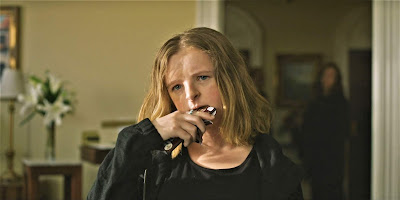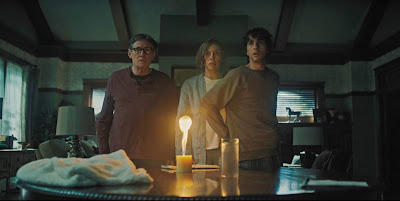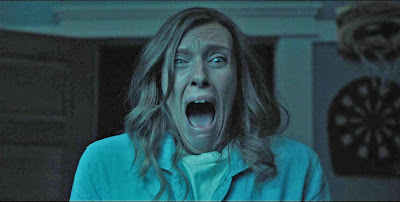Like every other Black family I knew growing up, I was
raised in a household that normalized living with a savagely tortured semi-naked
white man. On the wall of the hallway leading from our living room to my bedroom
hung an ornately-framed painting of Jesus Christ nailed to the cross. This
meant that the first thing I saw each morning and the last thing I saw before bed
was the gruesome spectacle of a bearded, emaciated man captured in the throes of
unspeakable agony from having spikes driven through his hands and feet, and thorns
crammed into his skull. This nightmare tableau was illuminated by a tubular electric
light attached to a heavy, gilt-metal frame, and, as it was one of those lenticular,
Vari-Vue™ prints much-coveted among the Catholic set at the
time, when you stood in front of it and moved side to side, Jesus’ pleading, heavenward-cast
eyes would close and open.
That the painting’s over-the-top kitschiness disturbed me more than the pious torture porn it depicted speaks to why, in later years, my Catholic status graduated to lapsed. I always had a problem with what I came to view as the religion's glorification of suffering and the preponderant role violence plays in children's spiritual instruction. The alignment of violence and morality makes it all too easy to convince people to accept, justify, and even legitimize all manner of cruelty, repression, and brutality. Provided there's the reassurance of said carnage being carried out in the name of a perceived sense of righteousness, a presumed moral authority, or unquestioning fealty to religious dogma.
In the minds and hearts of many, the humane assumption exists that spirituality and violence represent a paradox and that they are inherently and at once at odds with one another. In the alternatingly glorious/grotesque very grim fairy tale that is Midsommar, director Ari Aster posits the dualist theory that spirituality and violence are, in actuality--and as one finds in all aspects of nature--symbiotically linked. Intensely and inextricably joined...dark and light, despair and joy...the winter and summer of human experience.
Director Ari Aster hit a horror home run with his breakout film debut Hereditary (2018), a harrowing shocker about a dysfunctional family crumbling under the weight of grief, mental illness, and the insidious machinations of a demonic cult. By contrasting the chaotic dynamics of an unstable family with the regimentally orderly rituals of a Satanic sect, Hereditary drew discomfiting parallels to the intersections of religion/cult, devout/fanatic, and tradition /predeterminism.
With Midsommar, we see Aster continuing to explore the world of single-word titles, family dysfunction, cultism, mental illness, how we process grief, unhealthy relationships, and the shriek factor of head trauma. The focus of this, his unsettling and sure-footed sophomore effort, has four American grad students visiting a Swedish commune to witness a 9-day midsummer celebration. The plot places Midsommar as a contemporary blood-descendant of Robin Hardy’s 1973 folk-horror classic The Wicker Man. But where The Wicker Man contrasted Christian extremism with pagan zealotry, Midsommar sees Aster casting his twisted gaze on our culture of isolation and souls left untethered and adrift in the pursuit of individualism. Then, provocatively juxtaposing it with the spirituality-based interdependence of a Swedish pagan commune.
 |
| Florence Pugh as Dani Ardor |
 |
| Jack Reynor as Christian Hughes |
 |
| Vilhelm Blomgren as Pelle |
 |
| William Jackson Harper as Josh |
 |
| Will Poulter as Mark |
Midsommar begins in winter. The heavy snowfall obscures the film's opening titles, forecasting the emotional cold front piercing the nearly four-year relationship of New York graduate students Dani Ardor (Florence Pugh) and Christian Hughes (Jack Reynor). Christian, an anthropology student with a sub-major in waffling and gaslighting, has been angling towards a breakup for a year but lingers out of fear of the alternative. Dani, an anxiety-prone psychology student who pops Ativan to cope with panic attacks and dysfunction-stress linked to her family in Minnesota, is an exposed nerve so steeped in denial about Christian’s emotional abuse she fails to notice half the content of their conversations consists of her apologizing.
Alas, at the precise moment when it's most evident that the dissolution of this relationship would be the healthiest outcome for all parties involved, a devastating tragedy sends Dani into an agonizing spiral of grief and despair. And in an instant, we realize the bonds of emotional neediness and the shackles of guilty resentment will be added to this already toxic union.
(Top) Christian
consoles a traumatized Dani after the death of her entire family, his face betraying
his feelings of entrapment. On the rare occasion when men in movies are shown
bearing any of the emotional weight of a relationship, it tends to be depicted
as a burden (1971’s Play Misty for Me [pictured] and Fatal Attraction
-1981 come to mind). But male-gaze identification is subverted in Midsommar—as Dani’s
anguish speaks more eloquently than Christian’s “good guy” sense of aggrieved obligation.
Six months later—winter to summer—finds Dani still traumatized and frozen
in the process of her bereavement. Meanwhile, Christian, by way of a profoundly hurtful and pusillanimous move, is on course to forging a passive breakup by surreptitiously accepting an
invitation from fellow anthropology student Pelle (Vilhelm Blomgren) to join
friends Josh (William Jackson Harper) and Mark (Will Poulter) on a trip to Hårga, Sweden for study. When Dani accidentally discovers Christian’s
plans, only codependency and utter isolation account for her accepting his
brazenly reluctant, 11th-hour invitation to join them
on their all-boys excursion. In an amusing touch that feels deliberate for a film in which the necessity of family is a major theme, scenes depicting the journey to Pelle’s “hometown” perfectly capture the traditional joyless torpor of "Are we there yet?" family vacations.
The arrival of the Americans to the hippie-like village of Hårga, a sunny paradise of smiling faces and flowers! flowers! everywhere, signals Midsommar’s entrance into The Wicker Man folk-horror territory. And if that sounds like a spoiler, it is. Midsommar’s horror doesn’t come from the shock of the unexpected (although there’s plenty of that to go around) so much as the dread of the foreordained and perhaps inevitable.
Since we know we’re watching a horror film, the depiction of Hårga as an idyllic, welcoming place of tranquility is discordantly unsettling from the get-go. A feeling compounded as details of the lives and traditions of the Hårgas come to light via elaborate ceremonial rituals that grow increasingly bizarre. Things initially perceived as benign—those wide-eyed smiles, the blissed-out solicitousness—take on a sinister air as the village’s overriding atmosphere of compliant conformity begins to feel less like being in the presence of worshippers of ancient pagan religion and more like being trapped in the clutches of a hyper-cheerful death-cult.
There’s a scene in Woody Allen's Hanna & Her Sisters where Max Von Sydow's character comments on having just seen a TV program about the Holocaust: "Intellectuals declaring their mystification over the systematic murder of millions. They can never answer the question 'How could it happen?' It's the wrong question. The question is, 'Why doesn't it happen more often?'"
In Midsommar, Aster uses nature’s inalterable earth schedule of changing seasons and the phase cycles of the sun to metaphorically comment on humanity’s own predetermined…even destructive…cycles. We accept that it is in our natures to seek connection, community, family, faith, and the shared expression of love and sorrow. But is it also an equal part of our human hard wiring to be desirous of and susceptible to codependence, collectivism, religious populism, and moralized violence? The blood-stained global record of history repeating would say yes.
 |
| "You're out of the woods, you're out of the dark, you're out of the night. Step into the sun, step into the light." Midsommar's The Wizard of Oz moment. |
Hereditary was my favorite film of 2018, so after seeing Midsommar’s poster (it seems like ever since Naomi Watts in tears served as poster art for 2007’s Funny Games, crying faces came to replace screaming faces on horror movie posters), I was uncommonly stoked for its June 24, 2019 release.
My reaction to seeing Midsommar for the first time was a kind of mental loss of equilibrium. So much of it played out like an extended anxiety dream I had to watch it twice just to appreciate how Aster built such a compellingly unique and disturbing film out of what is essentially a dramatization of a psychotic break (Ari Aster is the king of Nervous Breakdown Horror). The movie is so hallucinatory and weird that when my partner and I watched the 24-minutes-longer director's cut a year later (it was his first time, my fourth), he was certain the film would end (like The Wizard of Oz) with everything revealed to have been a dream.
The difference between the theatrical and director’s cuts lie chiefly in the latter’s ability to expand on a few themes (the cult viewed through the prism of white supremacy and Anglo-European nativism, for example) and provide broader context and insight into the unhealthy dynamics of Dani and Christian’s relationship.
 |
| Swedish actor Bjorn Andresen as Dan, a man at the end of his Harga life cycle in Midsommar. At age 15, Andresen portrayed Tadzio, the symbol of youth in Luchino Visconti's Death in Venice (1971). |
I loved every minute of Midsommar. So grateful that once again Aster was expanding the concept of what "horror" films can be and impressed by how...no matter how far out the film went...the psychological drama remained the most dynamic and moving element.
WHAT I LOVE ABOUT THIS FILM
Loaded with challenging themes and disturbing images, there’s so much to unpack in Midsommar. It's hard to even nail it down to a single genre, much less walk away with a singular sense of what it’s all about. Like Jordan Peele’s US (2019), Midsommar is a puzzle of a film that, by staunchly refusing to explain itself, courts ambiguity and invites multiple interpretations. As one of the film’s creators remarked in an interview, what one comes away with after seeing Midsommar has a great deal to do with what one came to it with.
At its most elemental level, Midsommar is a story about the worst breakup on record. Many saw the film as a woman's journey of empowerment, leading to a cleansed-by-fire finale that brings our heroine the love and acceptance of a chosen family. At a price.Another persuasive take is that the film explores the pernicious allure of religion and cultism to the vulnerable. Drawing black comedy parallels between the elements of dysfunctional personal relationships (codependency, brainwashing, control, isolation, making self-negating sacrifices) and religious addictions. This view finds the ending to be far from a happy one, as Dani is seen to have traded one codependent attachment for another.Jordan Peele's Get Out (2017) tapped into the reality of the danger white spaces pose for Black lives. This perspective sees Midsommar equating the all-white commune's obsession with blood purity (see: the quick dispatch of Connie & Simon) as reflective of the current climate of exploit-then-erase racism, anti-immigrant nationalism, white supremacy, and the proliferation of hate groups.
The thing that grounds all these scenarios and makes them work, no matter how high-flown or fantastic, is the emotional truth & depth of the character of Dani. As written, and especially as portrayed by the remarkable Florence Pugh, Dani’s recognizable humanity tethers Midsommar’s nightmare landscape to an authentic, shared emotional reality that anchors the film to the real world.
THE STUFF OF DREAMS
Memories of my Catholic upbringing kicked in big-time watching Midsommar, specifically concerning the role sadistic violence and death play in Hårga tradition. Like the grisly Christian artwork that greeted me each morning as a child, the walls throughout the Hårga village are covered with violent biblical/religious imagery. In the film, every ritual human sacrifice and blood offering to the gods share one thing in common: cruelty seems to be the point. That none of those sacrificed are dispatched mercifully or in even remotely humane ways (indeed, some methods appear to be needlessly sadistic) reminded me of when, as a youngster, I was told that stories in the Bible were so violent and full of death and suffering because they wanted to convey God's wrath and power. A sort of "Scared Straight" method of discouraging sin.
Midsommar proposes something similar in suggesting that the violence embraced in the Hårga rituals is a form of acknowledging nature's power and ultimate dominance. Fine, but then the human element enters into it. When we learn that resentment is a motive behind Ingemar's sacrifice selection, the point is reinforced that people have always twisted and perverted spirituality and religion to fit their own needs, justify their prejudices, and morally rationalize their innate brutality.
 |
| It's so nice to be insane. No one asks you to explain. |
The above line is a lyric from the 1975 Helen Reddy song "Angie Baby" and clues you into my particular take on Midsommar's famously ambiguous final image. I take the position that mental illness has always been a struggle with Dani (when Pelle asks her if she’s studying psychiatry--Dani: “Psychology. That’s how you know I'm nuts.” Pelle: “Yeah. Also, that funny look in your eye”). Given Dani's family history (her sister's bipolarism), the emotional toll of her family's death (Dani's anguish is laceratingly deep), and what she 'settles for' in her relationship with the emotionally unavailable Christian, all indicate that she is in no mental condition to process the horrors visited upon her psyche at the commune. Something in her would have to give in order to make sense of all gory the madness.
It's my opinion that Dani has most definitely lost her mind at the end (a descriptive passage from the screenplay reads --"She has surrendered to a joy known only by the insane" ). Still, it appears her break from reality brings her a freedom and sense of peace heretofore elusive in her life. It also places her among and on even footing with the demented Hårga death cultists with whom she has finally found love, community, family, and acceptance.
It’s a monstrously sad/happy ending quite fitting with Midsommar's perversely optimistic view of fatalism. I don't see how any sane person could keep their sanity long in Hårga (and it's unlikely they would ever have allowed her to leave and possibly tell others about this place of ritual murder), so, in its way, the ending is also quite merciful to Dani, a character I came to like and care a great deal about over the course of the film. I agree with those who have called the ending horrible and beautiful.
It is. Just like Midsommar.
 |
| Here's something to chew on: Midsommar ends on something like the 4th or 5th day of a 9-day midsummer festival! What the hell could they have lined up next on the schedule? |
Copyright © Ken Anderson 2009 - 2020








































